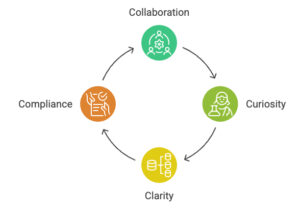Data has become the lifeblood of every intelligent enterprise. Yet for many organizations, data remains fragmented, trapped in silos, locked in legacy systems, and under utilised by teams who need insights the most.
In a world where AI-driven decisions, predictive analytics, and real-time insights define competitiveness, traditional architectures simply can’t keep up. What’s needed now is a future-ready data architecture, one that unifies data across systems, scales effortlessly, and empowers intelligence at every level of the business.So how do enterprises evolve from static databases to dynamic, AI-ready ecosystems?
This article explores the key principles, frameworks, and use cases that help organizations build future-ready data architectures capable of powering the intelligent enterprise of tomorrow.
Why Data Architecture Defines the Intelligent Enterprise
The term “intelligent enterprise” isn’t just a buzzword anymore, it’s a business necessity. Intelligent enterprises can sense, learn, and respond using data and AI, driving decisions that are faster, smarter, and more adaptive
But this intelligence depends on one thing: a strong architectural foundation. Without modern architecture, even the most advanced AI tools struggle to deliver consistent value. Consider a global retailer that unified its supply chain, customer, and sales data into a single cloud-based data lake. The result? Predictive models improved demand forecasting accuracy by 30%, while reducing stockouts by 22%.
Takeaway: Future-ready data architectures aren’t just about data storage, they’re about enabling continuous learning and business agility.
The Problem with Legacy and Fragmented Data Systems
Most enterprises still operate with data environments that were never designed for today’s demands. These legacy systems create hidden costs and barriers:
- Data silos prevent holistic insight and collaboration.
- On-prem bottlenecks slow analytics and AI deployment.
- Poor data quality undermines trust and compliance.
- Duplicated storage inflates cloud costs and complexity.
Take the example of a global financial firm that struggled to consolidate regional data for compliance reporting. Each business unit used different data models, resulting in delays and costly manual reconciliation. Only after adopting a unified data architecture with centralized governance did they achieve consistent, auditable insights across operations.
The lesson: Fragmented data slows innovation. Integrated data architectures accelerate it.
The 5 Pillars of a Future-Ready Data Architecture
To modernize effectively, enterprises should focus on five architectural pillars that ensure scalability, intelligence, and trust.
Unified Data Foundation
At the heart of every intelligent enterprise lies an integrated data foundation that breaks silos and harmonizes formats. Technologies like data fabric and data mesh enable organizations to connect structured and unstructured data across cloud, on-prem, and edge environments without massive re-engineering.
- Data Fabric works best for centralized governance and real-time integration
- Data Mesh suits large enterprises with distributed teams managing domain-specific data.
Platforms such as Databricks, Snowflake, and Azure Synapse support both models, giving flexibility and interoperability.
Scalable Cloud-Native Infrastructure
AI and analytics thrive on scalability. A cloud-native architecture ensures elastic compute and storage to handle fluctuating workloads and real-time queries.
By leveraging containerization (Kubernetes) and microservices, enterprises can deploy modular, flexible data pipelines that grow with business needs. Adopting multi-cloud or hybrid setups also helps reduce vendor lock-in and increase resilience, critical for data continuity in distributed systems.
Discover how our Cloud Transformation services empower enterprises to build scalable and secure data infrastructures.
Intelligent Data Governance
Data without governance leads to chaos. A governance-first approach ensures data remains accurate, compliant, and secure, especially as AI models become more dependent on data integrity. Modern tools use AI to automate governance, enabling:
- Automated data cataloging and lineage tracking.
- Policy enforcement and compliance monitoring.
- Anomaly detection to flag outliers or potential breaches.
An intelligent governance layer builds trust in data, which is essential for scaling AI responsibly.
Data Observability and Automation
Once data pipelines are live, observability keeps them healthy. Observability enables teams to monitor data quality, performance, and lineage in real time, similar to how DevOps monitors system uptime.
Leading enterprises integrate data observability platforms to predict issues before they impact analytics.
For example, a telecom provider reduced downtime by 40% after implementing observability AI to automatically detect latency spikes and schema mismatches.
AI-Ready Architecture Layer
Finally, a future-ready data architecture must be AI-native by design. This means embedding MLOps, vector databases, and real-time inference layers that allow machine learning models to interact directly with live data streams. An AI-ready layer transforms raw data into a living, learning system, enabling predictive maintenance, customer intelligence, and adaptive decision-making.
Pairing these architectures with AI Agent Development solutions can help organizations operationalize intelligence across customer service, supply chain, and risk management functions.
Ready to future-proof your data ecosystem? Connect with our AI experts or explore our AI Strategy Consulting solutions.
The “3A” Model for Data Architecture Modernization
This simple model helps enterprises navigate modernization with clarity and purpose.
| Stage | Objective | Key Actions |
|---|---|---|
| Adapt | Identify legacy bottlenecks | Map current systems, modernize ingestion pipelines |
| Align | Connect architecture to business goals | Define KPIs and AI-driven outcomes |
| Automate | Enable continuous intelligence | Embed automation in governance and analytics |
Example: A healthcare company used the 3A model to modernize its patient data ecosystem. By aligning modernization with patient outcome KPIs, they cut claim processing time by 35% and improved model deployment frequency fivefold.
Want to assess your data modernization maturity? Explore our Data Modernization Services to accelerate your journey.
Use Cases: Future-Ready Architectures in Action
Case 1 — Supply Chain Intelligence
A global manufacturer unified its ERP, IoT sensor, and logistics data under a data fabric. The outcome:
- Predictive forecasting accuracy: +28%.
- Inventory optimization: -18% carrying costs.
- Faster decision cycles: Real-time dashboards for plant operations.
Insight: Architecture drives agility, and agility drives profit.
Case 2 — Financial Risk & Compliance
A multinational bank built a governed, cloud-native data platform to manage millions of transactions daily.
- Real-time fraud detection.
- Automated compliance reporting.
- Streamlined audit trails for regulators.
This transformation reduced compliance reporting time from weeks to hours.
Case 3 — Customer Experience Transformation
A retail enterprise integrated data across CRM, e-commerce, and marketing channels using a data mesh approach. With unified customer views, they achieved personalized recommendations at scale, boosting engagement rates by 24% and retention by 15%.
Takeaway: Modern architectures turn fragmented touchpoints into connected experiences.
Measuring the Impact of Modern Data Architectures
Building a future-ready data architecture is only half the battle, measuring its success ensures continuous improvement.
Key KPIs to Track:
- Time-to-insight: How quickly can business teams extract value?
- Data pipeline uptime: Are systems consistently reliable?
- Cost efficiency: Are cloud and compute costs optimized?
- Model deployment time: How fast can AI models go live?
Building a Future-Ready Data Culture
Technology alone doesn’t modernize an enterprise, culture does. A future-ready data culture emphasizes cross-functional collaboration, data literacy, and governance discipline.
The 4Cs of Data Culture:

- Collaboration – Business and tech teams co-own outcomes.
- Curiosity – Encourage experimentation and data-driven hypotheses.
- Clarity – Define data ownership and accountability.
- Compliance – Ensure ethical and regulatory standards are upheld.
Companies that embed data culture see 2x higher innovation ROI and reduced operational friction.
Engage with our AI Strategy Consulting team to help build enterprise-wide AI and data literacy programs.
How to Get Started
Here’s a 4-step roadmap to building your future-ready data architecture:
- Audit your current data ecosystem – Identify gaps, redundancies, and bottlenecks.
- Define business-aligned goals – Link architecture improvements to KPIs like speed, cost, or AI outcomes.
- Select the right pattern – Choose between data fabric, mesh, or hybrid models based on scale and governance needs.
- Pilot and measure – Start with a focused, measurable AI use case before scaling organization-wide.
Conclusion
The future belongs to enterprises that treat data not as a byproduct, but as a strategic asset driving intelligence, innovation, and impact. A future-ready data architecture doesn’t just store information; it activates it, transforming static data into dynamic intelligence that fuels growth.
The message is clear:
- Those who modernize now will lead tomorrow’s AI-driven economy.
- Those who wait will find themselves decoding yesterday’s data in a world that’s already moved on.
If your organization is ready to move beyond managing data to truly mastering it, now is the time to take action. Partner with our experts to build a future-ready data architecture that empowers your business with intelligence, agility, and innovation turning your data into a powerful engine for growth and transformation.




